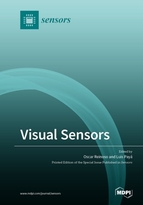Visual Sensors
A special issue of Sensors (ISSN 1424-8220). This special issue belongs to the section "Physical Sensors".
Deadline for manuscript submissions: closed (31 January 2019) | Viewed by 177726
Special Issue Editors
Interests: computer vision; omnidirectional imaging; appearance descriptors; image processing; mobile robotics; environment modeling; visual localization
Special Issues, Collections and Topics in MDPI journals
Interests: computer vision; robotics; cooperative robotics
Special Issues, Collections and Topics in MDPI journals
Special Issue Information
Dear Colleagues,
Visual sensors are able to capture a large quantity of information from the environment around them. Nowadays, a wide variety of visual systems can be found, from the classical monocular systems to omnidirectional, RGB-D and more sophisticated 3D systems. Every configuration presents some specific characteristics that make them useful to solve different problems. Their range of applications is wide and varied. Amongst them, we can find robotics, industry, agriculture, quality control, visual inspection, surveillance, autonomous driving and navigation aid systems.
Visual systems can be used to obtain relevant information from the environment, which can be processed to solve a specific problem. The aim of this Special Issue is to present some of the possibilities that vision systems offer, focusing on the different configurations that can be used and novel applications in any field. Furthermore, reviews presenting a deep analysis of a specific problem and the use of vision systems to address it would also be appropriate.
This Special Issue invites contributions in the following topics (but is not limited to them):
- Image analysis.
- Visual pattern recognition.
- Object recognition by visual sensors.
- Movement estimation or registration from images.
- Visual sensors in robotics.
- Visual sensors in industrial applications.
- Computer vision for quality evaluation.
- Visual sensors in agriculture.
- Computer vision in autonomous driving.
- Environment modeling and reconstruction from images.
- Visual Localization.
- Visual SLAM.
Prof. Dr. Oscar Reinoso
Dr. Luis Payá
Guest Editors
Manuscript Submission Information
Manuscripts should be submitted online at www.mdpi.com by registering and logging in to this website. Once you are registered, click here to go to the submission form. Manuscripts can be submitted until the deadline. All submissions that pass pre-check are peer-reviewed. Accepted papers will be published continuously in the journal (as soon as accepted) and will be listed together on the special issue website. Research articles, review articles as well as short communications are invited. For planned papers, a title and short abstract (about 100 words) can be sent to the Editorial Office for announcement on this website.
Submitted manuscripts should not have been published previously, nor be under consideration for publication elsewhere (except conference proceedings papers). All manuscripts are thoroughly refereed through a single-blind peer-review process. A guide for authors and other relevant information for submission of manuscripts is available on the Instructions for Authors page. Sensors is an international peer-reviewed open access semimonthly journal published by MDPI.
Please visit the Instructions for Authors page before submitting a manuscript. The Article Processing Charge (APC) for publication in this open access journal is 2600 CHF (Swiss Francs). Submitted papers should be well formatted and use good English. Authors may use MDPI's English editing service prior to publication or during author revisions.
Keywords
- 3D imaging
- Stereo visual systems
- Omnidirectional visual systems
- Quality assessment
- Pattern recognition
- Visual registration
- Visual navigation
- Visual mapping
- LiDAR/vision system
- Multi-visual sensors
- RGB-D cameras
- Fusion of visual information
- Networks of visual sensors








